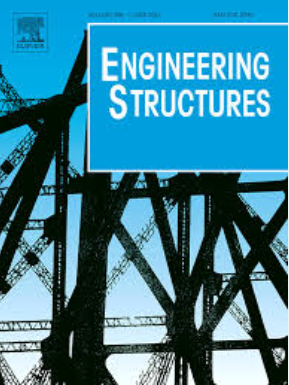钢筋在混凝土角处的锚固:实验和精确测量
IF 6.4
1区 工程技术
Q1 ENGINEERING, CIVIL
引用次数: 0
摘要
钢筋混凝土锚固是一种复杂的现象,受多种因素的影响,通常有几种破坏模式,包括:拉出破坏、劈裂破坏、侧剥落破坏、边楔剥落破坏和角部剥落破坏。广泛的研究集中在前四种破坏模式上,然而,关于角部剥落的详细信息在文献中很少。本文提出了一项旨在更好地了解混凝土角部锚固的力学响应和性能的研究。调查包括在圆柱形开口中使用液压充气装置进行一系列内压测试,并在靠近角落的锚固处进行拉出测试。研究了工程实践中常用的混凝土覆盖层、浇筑位置、约束指数、锚固长度等参数对锚固效果的影响。通过详细的测量,深入了解了角锚的局部和全局行为、阻力和破坏机制,并进行了深入的讨论。结果进一步与边缘锚固因楔块剥落而破坏的响应进行了比较,表明浇筑位置对角锚的影响不如边锚显著,因为压力引起的倾斜裂缝面与亚水平沉降裂缝不对齐。此外,由于应力再分配能力有限,角锚比边缘锚具有更小的阻力,并且具有相同的覆盖层和长度。在此基础上,建立并验证了计算角部剥落阻力的力学模型,该模型与试验结果吻合较好,为建立统一的不同模式锚固破坏力学模型迈出了一步。本研究强调,欧洲规范2 (FprEN 1992-1-1:2023)倾向于提供拐角锚固的非保守预测。本文章由计算机程序翻译,如有差异,请以英文原文为准。
Anchorage of reinforcement in concrete corners: Experiments and refined measurements
The anchorage of reinforcement in concrete is a complex phenomenon typically governed by several failure modes, including: pull-out failure, splitting, side spalling, edge wedge spalling, and corner spalling, depending on multiple factors. Extensive research has focused on the first four failure modes, however there is little detailed information in the literature regarding corner spalling. This paper presents an investigation aimed at better understanding the mechanical response and performance of anchorages in concrete corners. The investigation involves a series of inner-pressure tests performed with hydraulic inflator devices in cylindrical openings and pull-out tests on anchorages positioned near the corner. The effects of parameters commonly adopted in engineering practice are investigated, including concrete cover, casting position, confinement index, and anchorage length. Through detailed measurements, insights into the local and global behaviour, resistance, and failure mechanisms of corner anchorages are gained and thoroughly discussed. The results are further compared with the response of edge anchorages which failed due to wedge spalling, demonstrating that the effect of the casting position is less significant for corner anchorages than that for edge anchorages, as the inclined cracking plane caused by pressure does not align with sub-horizontal settlement cracks. Additionally, corner anchorages exhibit smaller resistances than edge anchorages with similar covers and lengths, due to limited stress redistribution capacity and more brittle behavior. On that basis, a mechanical model for calculating the corner spalling resistance is developed and validated, showing consistent agreement with the experimental results, which can be regarded as a step forward in the development of a unified mechanical model for anchorages that fail in different modes. This study underscores that Eurocode 2 (FprEN 1992–1–1:2023) tends to provide unconservative predictions for corner anchorages.
求助全文
通过发布文献求助,成功后即可免费获取论文全文。
去求助
来源期刊

Engineering Structures
工程技术-工程:土木
CiteScore
10.20
自引率
14.50%
发文量
1385
审稿时长
67 days
期刊介绍:
Engineering Structures provides a forum for a broad blend of scientific and technical papers to reflect the evolving needs of the structural engineering and structural mechanics communities. Particularly welcome are contributions dealing with applications of structural engineering and mechanics principles in all areas of technology. The journal aspires to a broad and integrated coverage of the effects of dynamic loadings and of the modelling techniques whereby the structural response to these loadings may be computed.
The scope of Engineering Structures encompasses, but is not restricted to, the following areas: infrastructure engineering; earthquake engineering; structure-fluid-soil interaction; wind engineering; fire engineering; blast engineering; structural reliability/stability; life assessment/integrity; structural health monitoring; multi-hazard engineering; structural dynamics; optimization; expert systems; experimental modelling; performance-based design; multiscale analysis; value engineering.
Topics of interest include: tall buildings; innovative structures; environmentally responsive structures; bridges; stadiums; commercial and public buildings; transmission towers; television and telecommunication masts; foldable structures; cooling towers; plates and shells; suspension structures; protective structures; smart structures; nuclear reactors; dams; pressure vessels; pipelines; tunnels.
Engineering Structures also publishes review articles, short communications and discussions, book reviews, and a diary on international events related to any aspect of structural engineering.
 求助内容:
求助内容: 应助结果提醒方式:
应助结果提醒方式:


